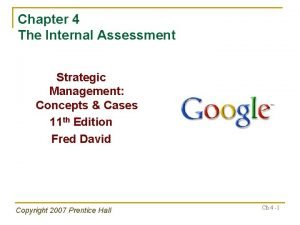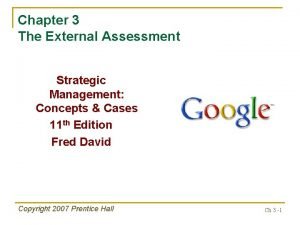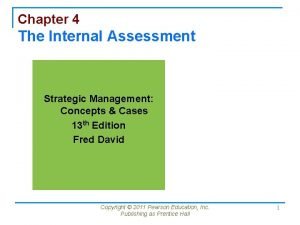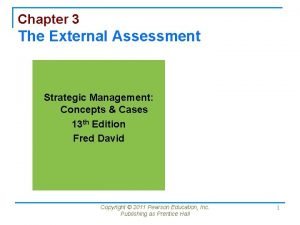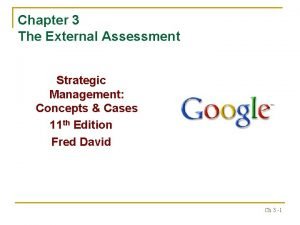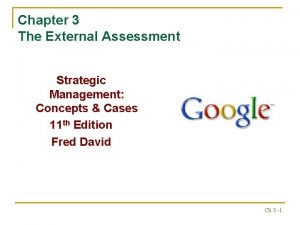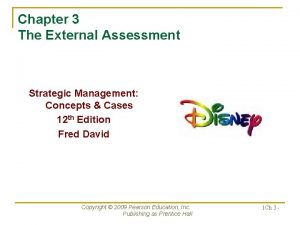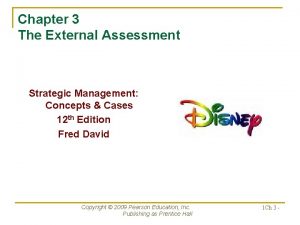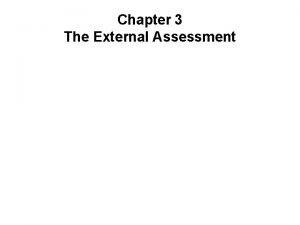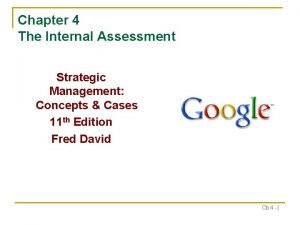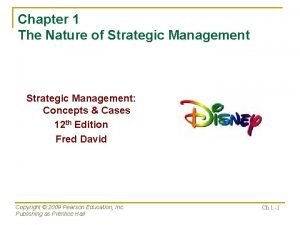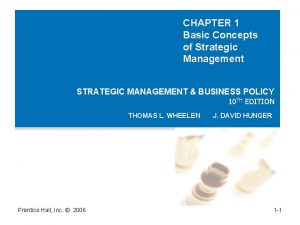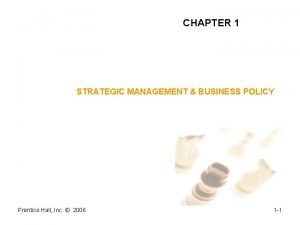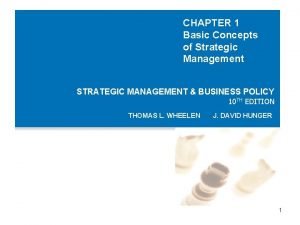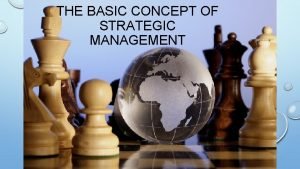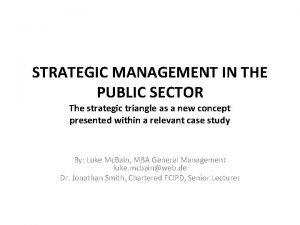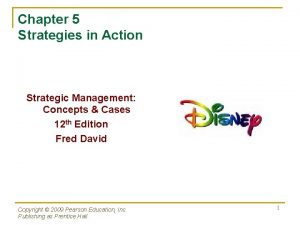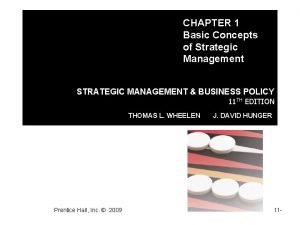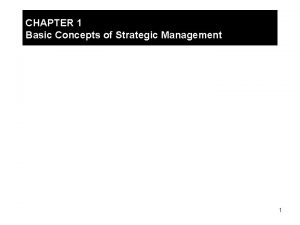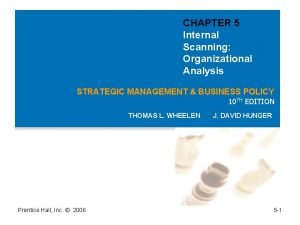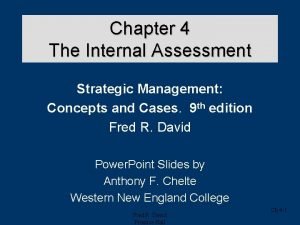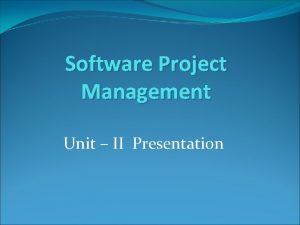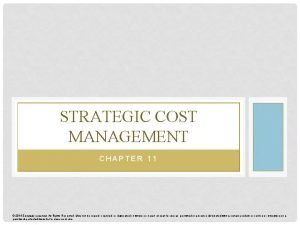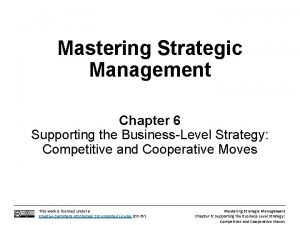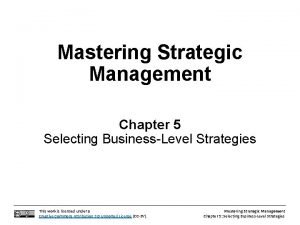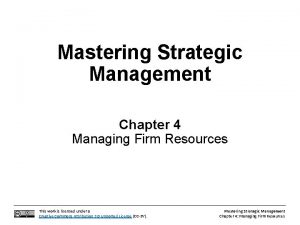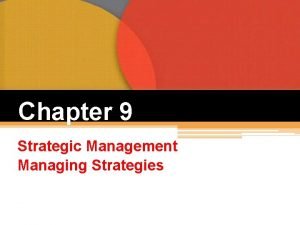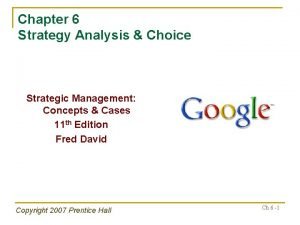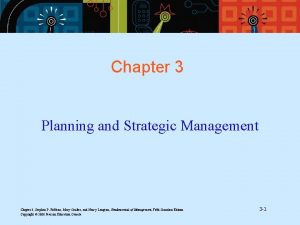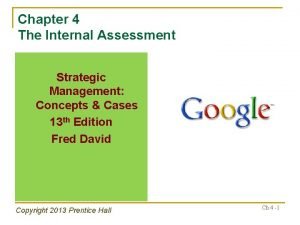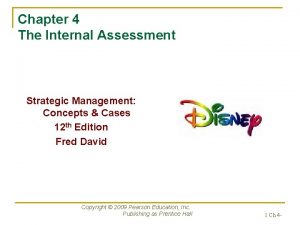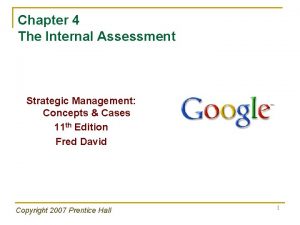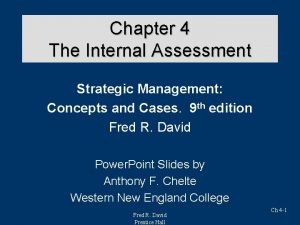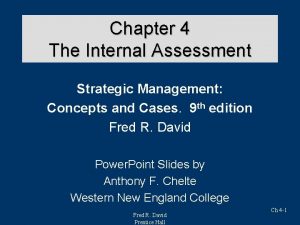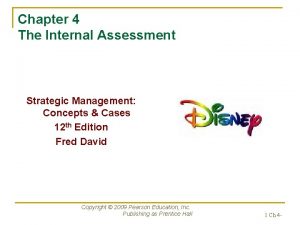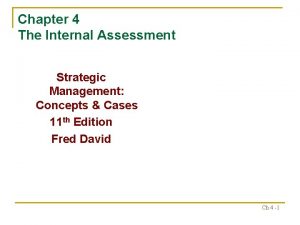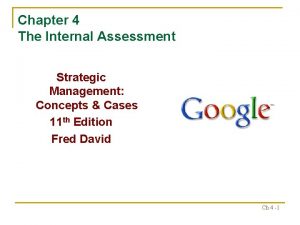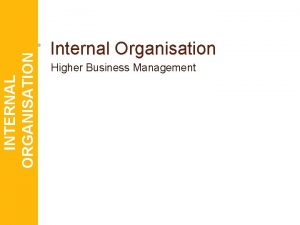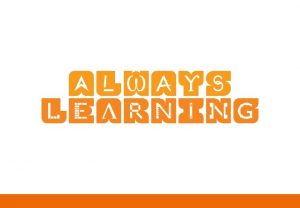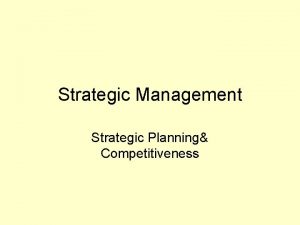Chapter 4 The Internal Assessment Strategic Management Concepts











































- Slides: 43

Chapter 4 The Internal Assessment Strategic Management: Concepts and Cases. 9 th edition Fred R. David Power. Point Slides by Anthony F. Chelte Western New England College Fred R. David Prentice Hall Ch 4 -1

Chapter Outline • The Nature of an Internal Audit • Integrating Strategy and Culture • Management Fred R. David Prentice Hall Ch 4 -2

Chapter Outline • Marketing • Finance/Accounting • Production/Operations Fred R. David Prentice Hall Ch 4 -3

Chapter Outline • Research and Development • Management Information Systems • The Internal Factor Evaluation Matrix (IFE) Fred R. David Prentice Hall Ch 4 -4

The Internal Assessment Great spirits have always encountered violent opposition from mediocre minds. -- Albert Einstein Fred R. David Prentice Hall Ch 4 -5

Nature of an Internal Audit All organizations – Strengths • Weaknesses • Fred R. David Prentice Hall Ch 4 -6

Key Internal Forces Distinctive Competencies • A firm’s strengths that cannot be easily matched or imitated by competitors • Building competitive advantage involves taking advantage of distinctive competencies • Strategies designed in part to improve on a firm’s weaknesses and turn to strengths Fred R. David Prentice Hall Ch 4 -7

Internal Audit Involvement in performing an internal strategic-management audit provides vehicle for understanding nature and effect of decisions in other functional business areas of the firm. Fred R. David Prentice Hall Ch 4 -8

Internal Audit Key to organizational success: – Coordination and understanding among managers from all functional areas Fred R. David Prentice Hall Ch 4 -9

Internal Audit Functional relationships: – Number and complexity increases relative to organization size Fred R. David Prentice Hall Ch 4 -10

Internal Audit Financial Ratio Analysis: – Exemplifies complexity of relationships among functional areas of the business Fred R. David Prentice Hall Ch 4 -11

Resource Based View The Resource Based View (RBV) approach to competitive advantage contends that internal resources are more important for a firm than external factors in achieving and sustaining competitive advantage. Internal factors can be grouped into three categories: Physical Resources Human Resources Organizational Resources Fred R. David Prentice Hall Ch 4 -12

Resource Based View • Empirical Indicators: – For a resource to be valuable it must be either Rare, hard to imitate or not easily substitutable. This is often called Empirical Indicators. – These three characteristics of resources enable a firm to implement strategies that improve its efficiency and effectiveness and lead to a sustainable competitive advantage. – The more a resource is rare, non-imitable and nonsubstitutable , the stronger a firm’s competitive advantage will be and the longer it will last. Fred R. David Prentice Hall Ch 4 -13

Integrating Strategy and Culture Organizational Culture – Pattern of behavior developed by an organization as it learns to cope with its problem of external adaptation and internal integration…is considered valid and taught to new members Fred R. David Prentice Hall Ch 4 -14

Integrating Strategy and Culture Organizational Culture - • Resistant to change • May represent a strength or weakness of the firm Fred R. David Prentice Hall Ch 4 -15

Integrating Strategy and Culture Cultural products Values beliefs rites rituals ceremonies myths stories legends sagas language symbols heroes Fred R. David Prentice Hall Ch 4 -16

Integrating Strategy and Culture can inhibit strategic management: – Miss changes in external environment because they are blinded by strongly held beliefs – When a culture has been effective in the past, natural tendency to stick with it in future, even during times of major strategic change Fred R. David Prentice Hall Ch 4 -17

Functions of Management Five basic activities – Planning – Organizing – Motivating – Staffing – Controlling – Fred R. David Prentice Hall Ch 4 -18

Functions of Management Function Stage When Most Important Planning Strategy Formulation Organizing Strategy Implementation Motivating Strategy Implementation Staffing Strategy Implementation Controlling Strategy Evaluation Fred R. David Prentice Hall Ch 4 -19

Planning Forecasting Establishing objectives Planning Devising strategies Developing policies Setting goals Fred R. David Prentice Hall Ch 4 -20

Functions of Management Organizing Achieve coordinated effort – Defining task and authority relationships – Departmentalization – Delegation of authority – Fred R. David Prentice Hall Ch 4 -21

Organizing Organizational design Job Job specialization Job descriptions Job Job specifications Span of of control Unity of ofcommand Coordination Job design Job Job analysis Organizing Fred R. David Prentice Hall Ch 4 -22

Functions of Management Motivating Influencing people to accomplish specific objectives – Communication is a major component – Fred R. David Prentice Hall Ch 4 -23

Motivating Leadership Communication Work groups Job enrichment Job satisfaction Needs fulfillment Organizational change Morale Motivating Fred R. David Prentice Hall Ch 4 -24

Functions of Management Staffing Personnel management – Human resources management – Fred R. David Prentice Hall Ch 4 -25

Staffing Wage & salary admin Employee benefits Interviewing Hiring Firing Training Management development Safety Affirmative action EEO Labor relations Career development Discipline procedures Management Staffing Fred R. David Prentice Hall Ch 4 -26

Functions of Management Controlling – Ensure actual operations conform to planned operations Fred R. David Prentice Hall Ch 4 -27

Controlling Management Quality control Financial control Sales control Inventory control Expense control Analysis of variances Rewards Sanctions Controlling Fred R. David Prentice Hall Ch 4 -28

Basic Financial Ratios • Ability to meet short term obligations Ratios Liquidity ratios Quick or Acid Test Ratio Fred R. David Prentice Hall Ch 4 -29

Basic Financial Ratios Extent of debt financing • Ratios Debt-to-total-assets Leverage ratios Debt-to-equity Long-term debt-to-equity Times-interest earned Fred R. David Prentice Hall Ch 4 -30

Basic Financial Ratios Effective use of firm’s resources • Ratios Inventory-turnover Activity ratios Fixed assets turnover Total assets turnover Accounts receivable turnover Average collection period Fred R. David Prentice Hall Ch 4 -31

Basic Financial Ratios Effectiveness shown by returns on sales and investment • Ratios Profitability ratios Gross profit margin Operating profit margin Net profit margin Return on total assets (ROA) Fred R. David Prentice Hall Ch 4 -32

Basic Financial Ratios • Effectiveness shown by returns on sales and investment Ratios Profitability ratios (continued) Return on stockholders’ equity (ROE) Earnings per share Price-earnings ratio Fred R. David Prentice Hall Ch 4 -33

Basic Financial Ratios • Firm’s ability to maintain economic position Ratios Growth ratios Sales Net income Earnings per share Dividends per share Fred R. David Prentice Hall Ch 4 -34

Finance/Accounting Audit • • • Are dividend payout policies reasonable? Does the firm have good relations with its investors and stockholders? Are the firm’s financial managers experienced and well trained? Fred R. David Prentice Hall Ch 4 -35

Value Chain Analysis Value chain analysis (VCA) refers to the process whereby a firm determines the costs associated with organizational activities from purchasing raw materials to manufacturing product(s) to marketing those products. VCA aims to identify where lowcost advantages or disadvantages exist anywhere along the value chain from raw material to customer service activities. VCA can enable a firm to better identify its own strengths and weaknesses, especially as compared to competitors’ value chain analyses and their own data examined over time. Ch 4 -36 Fred R. David Prentice Hall

Value Chain Analysis Substantial judgment may be required in performing a VCA because different items along the value chain may impact other items positively or negatively, so there exist complex interrelationships. For example, exceptional customer service may be especially expensive yet may reduce the costs of returns and increase revenues. Cost and price differences among rival firms can have their origins in activities performed by suppliers, distributors, Ch 4 -37 creditors, or even shareholders. Fred R. David Prentice Hall

Value Chain Analysis Firms should determine where cost advantages and disadvantages in their value chain occur relative to the value chain of rival firms. Fred R. David Prentice Hall Ch 4 -38

Benchmarking is an analytical tool used to determine whether a firm’s value chain activities are competitive compared to rivals and thus conducive to winning in the marketplace. Benchmarking entails measuring costs of value chain activities across an industry to determine “best practices” among competing firms for the purpose of duplicating or improving upon those best practices. Fred R. David Prentice Hall Ch 4 -39

Transforming Value Chain Activities into Sustained Competitive Advantage Fred R. David Prentice Hall Ch 4 -40

The Internal Factor Evaluation (IFE) Matrix A summary step in conducting an internal strategicmanagement audit is to construct an Internal Factor Evaluation (IFE) Matrix. This strategy-formulation tool summarizes and evaluates the major strengths and weaknesses in the functional areas of a business, and it also provides a basis for identifying and evaluating relationships among those areas. Fred R. David Prentice Hall Ch 4 -41

The Internal Factor Evaluation (IFE) Matrix An IFE Matrix can be developed in five steps: Fred R. David Prentice Hall Ch 4 -42

A Sample Internal Factor Evaluation Matrix for a Retail Computer Store Fred R. David Prentice Hall Ch 4 -43
 Internal assessment strategic management
Internal assessment strategic management The external assessment
The external assessment Exemplifies the complexity of relationships
Exemplifies the complexity of relationships External assessment in strategic management
External assessment in strategic management Competition in virtually all industries is
Competition in virtually all industries is Efe matrix of apple
Efe matrix of apple Internal and external assessment in strategic management
Internal and external assessment in strategic management Competition in virtually all industries is
Competition in virtually all industries is What is external audit in strategic management
What is external audit in strategic management What is external assessment in strategic management
What is external assessment in strategic management Internal assessment in strategic management
Internal assessment in strategic management Business ethics and strategic management
Business ethics and strategic management Basic concepts of strategic management
Basic concepts of strategic management Basic concept of strategic management
Basic concept of strategic management Basic concepts of strategic management
Basic concepts of strategic management Basic concept of strategic management
Basic concept of strategic management Strategic management in public sector
Strategic management in public sector Why is not advisable to pursue too many strategies at once
Why is not advisable to pursue too many strategies at once Basic concepts of strategic management
Basic concepts of strategic management Basic concepts of strategic management
Basic concepts of strategic management Industrial organization model of above average returns
Industrial organization model of above average returns Strategic analysis and choice in strategic management
Strategic analysis and choice in strategic management Internal scanning in strategic management
Internal scanning in strategic management Key internal forces in strategic management
Key internal forces in strategic management Internal scanning in strategic management
Internal scanning in strategic management Strategic assessment in spm
Strategic assessment in spm Project evaluation in software project management
Project evaluation in software project management Milton erickson
Milton erickson Strategic fit vs strategic intent
Strategic fit vs strategic intent Strategic complements and substitutes
Strategic complements and substitutes Consequences of an internally aligned structure
Consequences of an internally aligned structure Process of strategic cost management
Process of strategic cost management Mastering strategic management
Mastering strategic management Strategic management chapter 5
Strategic management chapter 5 Strategic management chapter 4
Strategic management chapter 4 Strategic management nature
Strategic management nature Strategic management
Strategic management Chapter 7 strategic management
Chapter 7 strategic management Chapter 7 strategic management
Chapter 7 strategic management Implementing strategies: management and operations issues
Implementing strategies: management and operations issues What are the two external dimensions of the space matrix?
What are the two external dimensions of the space matrix? Organization and management chapter 3 planning
Organization and management chapter 3 planning Strategic management chapter 7
Strategic management chapter 7 Implementing strategies management and operations issues
Implementing strategies management and operations issues
